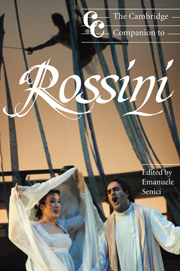13 - Singing Rossini
from Part IV - Performance
Published online by Cambridge University Press: 28 September 2011
Summary
What were Rossini's opinions on singing and its expressive capacities? What was his relationship to the Italian traditional school of singing? How did he relate to and interact with performers? Which voices and singers did he prefer? How did these personal views affect his style? Answering these questions means trying to understand not only how Rossini's works were performed when they first appeared, but also how we might achieve historically and aesthetically aware performances today. The many-faceted nature of Rossini's position can be seen, on the one hand, in his nostalgia for a bygone age and his taste for a singing style glorified as ‘antico’, and, on the other, in his fundamental innovations, which gave singing new life during a period when it was considered in a state of crisis. What unifies these different traits is the consistent privileging of the voice as a means of conveying emotion. Keeping this key aesthetic principle in mind, we need to consider the historical context in which Rossini worked, particularly with regard to the system of operatic production and the nature of the artistic rôles within it.
There is little explicit first-hand evidence from which to glean Rossini's relationship with the art of singing. His letters contain occasional remarks, but, although these are sometimes of significance, they lack an explicitly ‘authorial’ viewpoint, any attempt at sketching a system. Because of this relative lack of sources, and of the fact that Rossini rarely made public comments on the state of contemporary music, the writings of biographers who had the opportunity to note Rossini's opinions become particularly important.
- Type
- Chapter
- Information
- The Cambridge Companion to Rossini , pp. 187 - 203Publisher: Cambridge University PressPrint publication year: 2004

